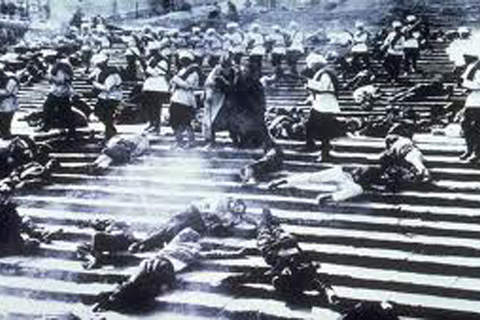
The Battleship Potempkin app for iPhone and iPad
Developer: B.I.A. Films
First release : 13 Oct 2010
App size: 284.06 Mb
The Battleship Potemkin has been called one of the most influential propaganda films of all time, and was named the greatest film of all time at the Brussels World Fair in 1958.
The Battleship Potemkin is a 1925 silent film directed by Sergei Eisenstein and produced by Mosfilm. It presents a dramatised version of the mutiny that occurred in 1905 when the crew of the Russian battleship Potemkin rebelled against their officers of the Tsarist regime.
The film is composed of five episodes.
"Men and Maggots", in which the sailors protest at having to eat rotten meat;
"Drama at the Harbour", in which the sailors mutiny and their leader, Vakulinchuk, is killed;
"A Dead Man Calls for Justice", in which Vakulinchuks body is mourned over by the people of Odessa;
"The Odessa Staircase", in which Tsarist soldiers massacre the Odessans;
"The Rendez-Vous with a Squadron", in which the squadron tasked with stopping the Potemkin instead declines to engage and its sailors cheer on the rebellious battleship.
The most celebrated scene in the film is the massacre of civilians on the Odessa Steps (also known as the Primorsky or Poem Stairs.) In this scene, the Tsars Cossacks in their white summer tunics march down a seemingly endless flight of steps in a rhythmic, machine-like fashion firing volleys into a crowd. The victims include a young boy and a mother who is pushing a baby in a baby carriage. As she falls to the ground, dying, she leans against the carriage, nudging it away; it rolls down the steps amidst the fleeing crowd.
The massacre on the steps is fictional, presumably created by Eisenstein for its dramatic venue and effect, as well as for propaganda and to demonise the Tsar and the Imperial regime. It is, however, based on the fact that there were widespread demonstrations in the area, sparked off by the arrival of the Potemkin in Odessa Harbour, and both The Times of London and the resident British Consul reported that troops fired on the crowds with accompanying loss of life (the actual number of casualties is unrecorded). Roger Ebert writes, "That there was, in fact, no czarist massacre on the Odessa Steps scarcely diminishes the power of the scene ... It is ironic that [Eisenstein] did it so well that today, the bloodshed on the Odessa steps is often referred to as if it really happened
Eisenstein wrote the film as a revolutionary propaganda film, but also used it to test his theories of "montage." The revolutionary Soviet filmmakers of the Kuleshov school of filmmaking were experimenting with the effect of film editing on audiences, and Eisenstein attempted to edit the film in such a way as to produce the greatest emotional response, so that the viewer would feel sympathy for the rebellious sailors of the Battleship Potemkin and hatred for their cruel overlords. In the manner of most propaganda, the characterisation is simple, so that the audience could clearly see with whom they should sympathise.


